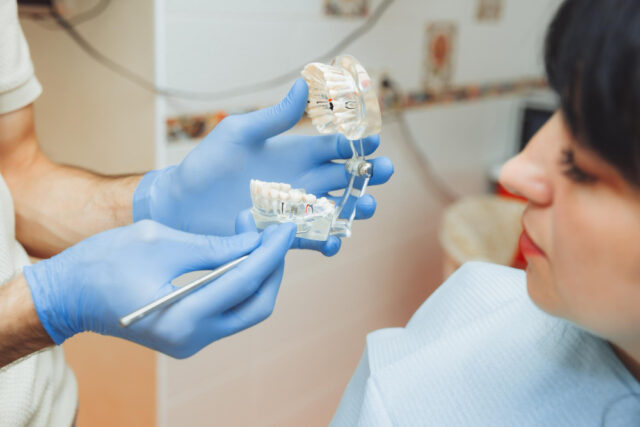
Determining the opportune time to seek orthodontic care presents a pivotal decision for both parents and adults in Edison. The American Association of Orthodontists establishes clear guidelines for initial evaluations, yet many patients miss these essential windows for intervention. While traditional metal braces remain familiar to most, modern orthodontic care encompasses a range of sophisticated treatment options. Understanding the key indicators and timing for orthodontic evaluation can dramatically impact both treatment outcomes and costs.
Common Signs Your Child Needs Orthodontic Care
Parents should monitor their children’s dental development for several key indicators that may signal the need for orthodontic intervention. Common warning signs include dental crowding, where teeth appear tightly packed or overlapping, and difficulties with biting or chewing. Misaligned teeth, particularly those that protrude or fail to meet properly when the jaw is closed, warrant professional evaluation.
Additional indicators include mouth breathing, thumb sucking beyond age five, and early or late loss of baby teeth. Children who experience jaw clicking, persistent mouth breathing, or speech impediments may also benefit from orthodontic assessment. The presence of gaps between teeth, asymmetrical facial features, or frequent cheek biting can signal underlying orthodontic issues that require professional attention. Early detection of these signs enables more effective treatment outcomes.
Key Age Milestones for First Orthodontic Evaluations
The American Association of Orthodontists recommends children receive their first orthodontic evaluation by age seven, when permanent teeth begin emerging and jaw development issues become detectable. During the early teen years, between ages 11-14, orthodontists conduct thorough assessments as this period presents an ideal window for beginning treatment due to active growth phases and increasing dental maturity. Adult evaluations follow different protocols since jaw growth is complete, requiring orthodontists to focus on current tooth positioning, bite mechanics, and potential complications from pre-existing dental work.
Age Seven First Visit
According to established guidelines from the American Association of Orthodontists, children should undergo their first orthodontic evaluation by age seven. At this critical developmental stage, orthodontists can effectively assess both present and potential future orthodontic issues.
By age seven, children typically have a mix of primary and permanent teeth, allowing orthodontists to evaluate tooth development patterns and bite formation. This timing enables early detection of problems such as crowding, crossbites, or emerging jaw misalignments. Early intervention at this age can prevent more severe complications and may reduce the need for extensive treatment later.
The initial evaluation also helps orthodontists monitor growth patterns, plan appropriate intervention timing, and identify habits like thumb-sucking that could affect dental development. This proactive approach often leads to more efficient and successful treatment outcomes.
Early Teen Assessment Window
While many children receive their initial orthodontic screening at age seven, early adolescence presents another pivotal evaluation window between ages 11–13. During this period, an experienced Orthodontist in Edison can effectively assess and address malocclusion issues as patients experience significant early adolescent growth.
This age range typically coincides with the emergence of most permanent teeth and critical developmental milestones that impact jaw alignment. Orthodontists can evaluate bite relationships, tooth positioning, and skeletal growth patterns with greater precision during this window. The timing is particularly advantageous for implementing corrective treatments like braces or clear aligners, as the jaw bones haven’t fully hardened and remain responsive to orthodontic intervention. Additionally, addressing alignment issues during this phase often leads to more predictable treatment outcomes and potentially shorter treatment durations.
Adult Evaluation Considerations
Beyond adolescent assessment windows, adult patients seeking orthodontic evaluations present distinct diagnostic considerations that differ from younger populations. Adult tooth alignment issues often involve decades of progressive shifting, while facial profile concerns may be more pronounced due to complete skeletal maturation.
Orthodontists evaluate several critical factors in adult cases, including bone density, periodontal health, and existing dental work such as crowns or bridges. The assessment must account for age-related changes in jaw structure, potential tooth wear, and the presence of temporomandibular joint (TMJ) disorders. Treatment planning for adults requires careful consideration of biomechanical forces, as mature bone responds differently to orthodontic pressure compared to developing adolescent structures. Additionally, orthodontists must factor in longer treatment durations and potential limitations in achieving ideal results.
Adult Indicators for Seeking Orthodontic Treatment
Several key indicators signal when adults should consider orthodontic treatment in Edison. Persistent discomfort during chewing, jaw pain, or difficulty maintaining proper oral hygiene due to misaligned bite patterns represent primary concerns. Adults experiencing tooth crowding issues, particularly in the anterior region, may notice progressive dental shifting that affects both functionality and aesthetics.
Additional indicators include excessive wear on tooth surfaces, recurring gum inflammation, and speech impediments related to malocclusion. Professional evaluation becomes necessary when adults observe changes in their bite relationship, develop gaps between teeth, or experience complications from previous dental work. Sleep disorders, including sleep apnea associated with jaw positioning, may also warrant orthodontic consultation. These symptoms often manifest gradually, making regular dental monitoring essential for ideal intervention timing.
The Impact of Delayed Orthodontic Care
Postponing necessary orthodontic treatment can lead to compounded dental complications that become increasingly difficult to correct over time. The cumulative effects of untreated orthodontic issues frequently result in deteriorating oral health conditions and escalating treatment costs.
Delayed growth impacts manifest in various ways, including improper jaw development, restricted dental arch formation, and compromised facial symmetry. These developmental issues often require more invasive interventions when addressed later in life. Additionally, misaligned bite consequences can progress to create excessive wear on tooth enamel, temporomandibular joint disorders (TMJ), and chronic headaches.
Early intervention allows orthodontists to guide proper dental development, potentially eliminating the need for extensive procedures such as tooth extraction or orthognathic surgery that may become necessary due to prolonged treatment postponement.
Understanding Different Treatment Options in Edison
Modern orthodontic practices in Edison offer patients an extensive range of treatment modalities tailored to address specific dental misalignment conditions. Through thorough diagnostic evaluations, orthodontists determine the most effective orthodontic appliance selection based on factors including bite irregularities, spacing issues, and skeletal relationships.
Treatment plan customization encompasses various options, from traditional metal braces to clear aligners and ceramic brackets. Edison practitioners utilize advanced imaging technology to create precise treatment protocols, considering factors such as age, lifestyle requirements, and severity of malocclusion. Self-ligating systems, lingual braces, and clear aligner therapy represent contemporary alternatives that address both functional and aesthetic concerns. Each treatment pathway is structured to achieve ideal outcomes while accommodating patient preferences and clinical requirements within the established treatment timeline.
Early Intervention Benefits and Preventive Care
Early detection of orthodontic issues through regular screenings can identify problems like crowding, crossbites, and jaw misalignments before they become more severe. Preventive orthodontic care, typically recommended between ages 7-9, addresses developing issues through interceptive treatments such as palatal expanders, space maintainers, or partial braces. These early interventions often reduce the complexity and duration of future orthodontic treatment, potentially eliminating the need for tooth extractions or surgical procedures.
Early Signs and Symptoms
Recognizing the initial signs of orthodontic issues can substantially impact treatment outcomes and prevent more severe complications. Common indicators include difficulty biting or chewing, speech impediments, and persistent mouth breathing. Parents should monitor their children for misaligned teeth, crowding, or gaps between teeth that appear unusual for their developmental stage.
Observable symptoms often manifest as improper tooth positioning, including protruding upper teeth, crossbites, or teeth that don’t meet properly when closing the mouth. Additional warning signs include jaw clicking, frequent cheek biting, and thumb-sucking habits that persist beyond age five. Facial asymmetry, challenges in maintaining proper oral hygiene due to overcrowding, and early or late loss of baby teeth may also signal the need for orthodontic evaluation. These symptoms warrant prompt consultation with an Edison orthodontist.
Prevention vs. Future Treatment
Proactive orthodontic intervention during childhood can substantially reduce the complexity and duration of future treatments while minimizing potential complications. Early screening allows orthodontists to identify developing issues and implement preventive measures before they become more severe.
Key preventive interventions include space maintainers, palatal expanders, and early alignment correction, which can guide proper jaw development and tooth eruption patterns. These treatments often eliminate or reduce the need for extensive orthodontic work later in life, resulting in significant cost savings and shorter treatment periods.
The long-term impact of early intervention extends beyond dental aesthetics, affecting speech development, breathing patterns, and overall oral function. Research demonstrates that addressing orthodontic issues during developmental stages yields more stable results and reduces the likelihood of relapse compared to delayed treatment approaches.
Cost Considerations and Insurance Coverage
The financial aspects of orthodontic treatment in Edison typically range from $3,000 to $7,000, depending on the complexity of the case and the chosen treatment method. Most dental insurance plans provide partial coverage for orthodontic procedures, often covering 25% to 50% of the total cost. Many orthodontic practices in Edison offer affordable options through flexible payment plans, allowing patients to distribute costs over 12 to 24 months.
Patients should verify their insurance coverage details, including lifetime maximums and age restrictions, before beginning treatment. Some practices participate in healthcare financing programs like CareCredit or offer in-house financing solutions. Additionally, Health Savings Accounts (HSAs) and Flexible Spending Accounts (FSAs) can be utilized to pay for orthodontic treatment using pre-tax dollars, reducing the overall out-of-pocket expenses.
Choosing the Right Orthodontist in Edison
While financial considerations play a significant role in orthodontic treatment decisions, selecting a qualified orthodontist requires careful evaluation of multiple factors. Patients should verify orthodontist credentials, including board certification, educational background, and years of experience practicing in Edison. Professional memberships in organizations like the American Association of Orthodontists can indicate commitment to ongoing education and industry standards.
Prospective patients benefit from scheduling consultation appointments with multiple providers to assess treatment preferences, communication styles, and office protocols. Key considerations include the orthodontist’s approach to various correction methods, facility cleanliness, staff professionalism, and scheduling flexibility. Additionally, patients should evaluate the practice’s use of modern technology, emergency care provisions, and treatment monitoring procedures. Reviews from current and former patients can provide valuable insights into the orthodontist’s reliability and treatment outcomes.
What to Expect During Your Initial Consultation
During an initial orthodontic consultation, patients typically spend 60-90 minutes undergoing thorough evaluation procedures and discussing treatment options. The initial evaluation process includes exhaustive dental X-rays, digital photographs, and detailed impressions of the teeth and jaw structure.
The orthodontist examines the patient’s oral cavity, analyzing bite patterns, teeth alignment, and facial symmetry. Following this assessment, they review the diagnostic records to develop a customized treatment plan. Expectations during consultation include discussing various orthodontic approaches, treatment duration, cost estimates, and insurance coverage options.
The orthodontist also addresses specific concerns, explains maintenance requirements, and outlines potential challenges during treatment. Patients receive detailed information about appliance options, including traditional braces, clear aligners, or other corrective devices suitable for their specific case.
Frequently Asked Questions
How Long Do I Need to Wear a Retainer After Treatment?
Retainer wear duration varies individually, but permanent nighttime wear is typically recommended. Initial full-time wear lasts 3-6 months. Retainer wear importance cannot be overstated, as it prevents teeth from shifting back to pre-treatment positions.
Can I Play Musical Instruments While Wearing Braces?
Playing musical instruments with braces is possible, though patients may require adjusting playing habits. Wind and brass instrument players should focus on adapting instrument technique while their mouth adjusts to orthodontic appliances.
What Foods Should I Completely Avoid With Orthodontic Appliances?
Patients with orthodontic appliances should strictly avoid sticky foods like caramel, taffy, and gum, as well as hard crunchy foods including nuts, popcorn, and ice. These items can damage brackets and wires.
Are There Alternatives to Traditional Metal Braces for Athletes?
Clear aligners for athletes offer a sports-friendly orthodontic option, eliminating risks associated with metal brackets. Invisalign and similar removable aligners provide protection during contact sports while maintaining effective tooth movement treatment.
Do Orthodontic Adjustments Hurt, and How Long Does the Discomfort Last?
Orthodontic adjustments typically cause mild to moderate discomfort levels lasting 2-3 days. Pain management techniques include over-the-counter analgesics, soft foods, and orthodontic wax. Most patients report diminishing sensitivity with subsequent adjustments.
Disclaimer
The information contained in South Florida Reporter is for general information purposes only.
The South Florida Reporter assumes no responsibility for errors or omissions in the contents of the Service.
In no event shall the South Florida Reporter be liable for any special, direct, indirect, consequential, or incidental damages or any damages whatsoever, whether in an action of contract, negligence or other tort, arising out of or in connection with the use of the Service or the contents of the Service. The Company reserves the right to make additions, deletions, or modifications to the contents of the Service at any time without prior notice.
The Company does not warrant that the Service is free of viruses or other harmful components












